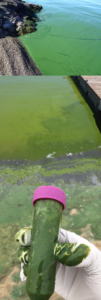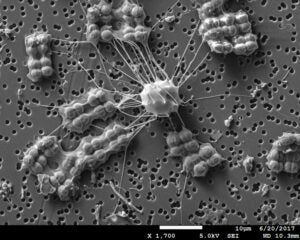 Studies of harmful algal blooms (HABs) in marine and freshwater ecosystems have usually been conducted by oceanographers or limnologists, respectively. Few investigations have considered both of these issues in a single study, in part because freshwater HAB toxins have generally been considered a public health issue exclusive to freshwater ecosystems. However, our own recent studies have shown that the toxins of some cyanobacteria (cyanotoxins) can be transported downstream from their freshwater origins, and can be found in many brackish and marine waterbodies. As a consequence, estuaries and nearshore coastal ecosystems may be impacted simultaneously by multiple algal and/or cyanobacterial toxins. We are investigating this possibility through a series of field-based studies, and through the establishment of a culture collection of cyanobacteria.
Studies of harmful algal blooms (HABs) in marine and freshwater ecosystems have usually been conducted by oceanographers or limnologists, respectively. Few investigations have considered both of these issues in a single study, in part because freshwater HAB toxins have generally been considered a public health issue exclusive to freshwater ecosystems. However, our own recent studies have shown that the toxins of some cyanobacteria (cyanotoxins) can be transported downstream from their freshwater origins, and can be found in many brackish and marine waterbodies. As a consequence, estuaries and nearshore coastal ecosystems may be impacted simultaneously by multiple algal and/or cyanobacterial toxins. We are investigating this possibility through a series of field-based studies, and through the establishment of a culture collection of cyanobacteria.
A survey conducted in collaboration with the Southern California Coastal Water Research Project, and other entities, recently documented the presence of numerous cyanobacterial species in a large number of freshwater ecosystems throughout southern California (see our Publications: Howard et al., 2017). Many of these water bodies had substantial amounts of a group of cyanotoxins called microcystins, powerful liver toxins that pose a threat to human and animal health. Another recent study documented multiple potentially-toxic cyanobacterial species, as well as multiple cyanotoxins in a number of lagoonal and river ecosystems along the coast of the Southern California Bight (see our Publications: Tatters et al., 2017).
 Field studies now underway in a select number of ecosystems employ a new passive monitoring tool called Solid Phase Adsorption Toxin Tracking (SPATT), as a means of documenting toxin occurrence. SPATT are small devices that can be deployed for up to a week in a water body. These devices employ a resin that binds substances dissolved in the water, and can be later retrieved and analyzed for multiple toxins. Combined with water and benthic samples to identify and culture potentially toxic cyanobacteria present at the sites, this work is helping to characterize the presence of marine and freshwater toxins, and the species that produce them, along the coast of California.
Field studies now underway in a select number of ecosystems employ a new passive monitoring tool called Solid Phase Adsorption Toxin Tracking (SPATT), as a means of documenting toxin occurrence. SPATT are small devices that can be deployed for up to a week in a water body. These devices employ a resin that binds substances dissolved in the water, and can be later retrieved and analyzed for multiple toxins. Combined with water and benthic samples to identify and culture potentially toxic cyanobacteria present at the sites, this work is helping to characterize the presence of marine and freshwater toxins, and the species that produce them, along the coast of California.
The specific objectives of this research are:
(1) to incorporate SPATT into existing monitoring programs and thereby demonstrate their usefulness for documenting HAB events;
(2) conduct field surveys at the land-sea interface in order to determine where and when HAB species and their toxins are of concern;
(3) contribute to a prototype HAB monitoring strategy at the land-sea interface that can be provided to management agencies, including specific guidance on methods for monitoring algal and cyanobacterial toxins using Solid Phase Adsorption Toxin Tracking (SPATT; Click HERE for Standard Operating Procedure);
(4) use live samples collected in the field studies to establish pure cultures of potentially harmful algae and cyanobacteria from our study sites;
(5) identify species brought into culture (morphological identification as well as sequencing 16S genes and/or ITS regions);
(6) provide cultures to other investigators for the documentation/characterization of toxins produced by cultured cyanobacteria, in order to link causative species to their toxins
 This research project contributes to the implementation of a statewide integrated monitoring strategy to improve of knowledge of algal and cyanobacterial toxins and toxigenic species.
This research project contributes to the implementation of a statewide integrated monitoring strategy to improve of knowledge of algal and cyanobacterial toxins and toxigenic species.
This research is funded by grants from the Monitoring and Event Response for Harmful Algal Blooms (MERHAB) program of NOAA (Title: Improving Tools for Monitoring Multiple HAB Toxins at the Land-Sea Interface in Coastal California: HAB-SICC), and the USC Sea Grant program (“Documenting Multiple Phycotoxins in Coastal Ecosystems of the California Coast”).